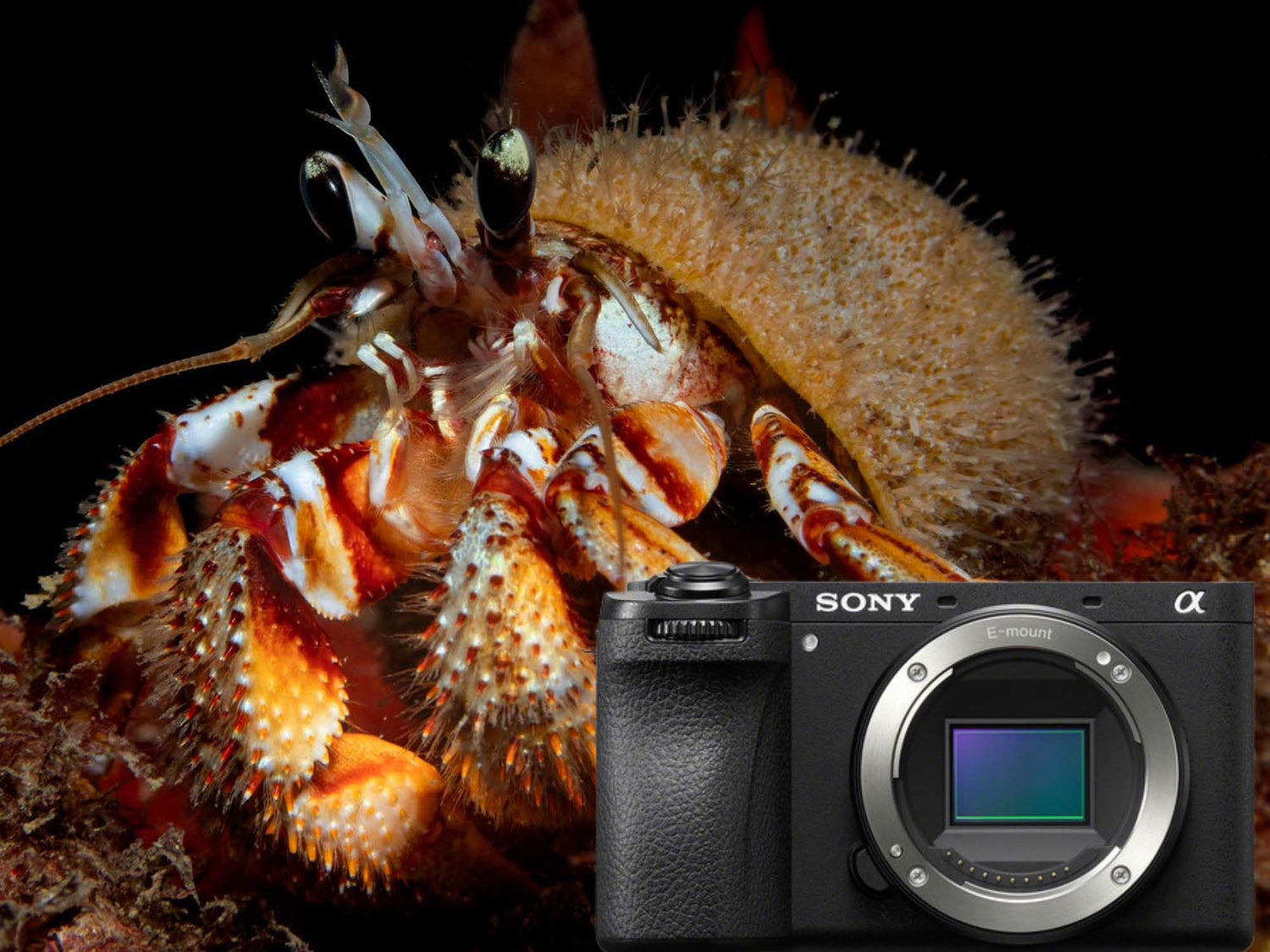Review by Jean Rydberg
Images © Nirupam Nigam
Four years after the release of the latest a6000-series camera, Sony gives us very powerful compact mirrorless option with the a6700 model.
Body & Electronics
Sony’s latest APS-C mirrorless camera features a 26 megapixel BSI CMOS sensor capable of burst shooting up to 11 frames per second (fps). The a6700 is a dual processor camera featuring a Bionz XR for image capture plus a dedicated processor for AI calculations.
Sony gave the new camera an updated menu system. We appreciate the detailed level of customizable controls that provide nearly endless possibilities for setting up the camera in a way that perfectly suits your shooting needs.

f/13 • 1/125 • ISO 320 • E PZ 16-50mm F3.5-5.6 OSS Lens © Nirupam Nigam
The Sony a6700 is very similar in size and weight to the a6600 model, with the notable addition of a front dial control at the top of the hand grip. While this control is not accessed via the 200DLM/E Underwater Housing, the camera provides two other customizable dial controls which can be used for quick access to exposure control settings underwater. We most commonly use them as Aperture and Shutter Speed when shooting still images or ISO and Aperture when shooting video.
The extended hand grip helps with comfort on the surface but overall the a6700 body style still gives off those boxy, compact-camera vibes. Once it’s in the housing you won’t mind as the controls translate to larger, more ergonomic knobs and push buttons.
The camera now features a USB-C charging and data transfer port on the side. However the corresponding DLM/E Underwater Housing is so small and form-fit that there’s no room to access it through the housing.

f/20 • 1/125 • ISO 250 • FE 90mm F2.8 Macro G OSS Lens © Nirupam Nigam
Autofocus
The a6700 has almost twice as many autofocus points as its predecessors - 759 in total - and they are spread across a larger area. The autofocus points cover nearly the entire screen which is particularly important in video where you subject may be moving in or out of the frame.
Sony is known for their industry-leading autofocus technology and we’re pleased to see that they have packed their latest AI-based AF technology into the a6700. Sony provides excellent subject recognition focus tracking (Human, Animal/Bird, Animal, Bird, Insect, Car/Train, Airplane).
Their menu options don’t include fish - no manufacturers do, yet - though we find that Sony does well to track fish eyes in any of the Animal, Bird, or Insect settings. Some of us here at Ikelite feel that Canon’s AF tracking is slightly stickier on fish eyes but there’s no question that Sony provides excellent performance and a good ‘hit’ rate when shooting macro.

“While animal eye AF in the camera is not updated for fish, it can still work well underwater. I was able to get the A6700 to find fish eyes and lock onto them about 60% of the time that I was using the macro lens when photographing small fish, like sculpin.” - Nirupam Nigam, Underwater Photography Guide

f/16 • 1/125 • ISO 250 • FE 90mm F2.8 Macro G OSS Lens © Nirupam Nigam
Video Capture
Video is a big strong suit of the a6700, being the only camera in its class to feature a 4K/120p mode for shooting slow motion video.
It also shoots oversampled 4K/60p footage which is more detailed than the Canon R7 in the same mode. The a6700 offers an ‘Active’ image stabilization mode saves gyro data with the video file so that you can tweak it in post-production using Sony’s Catalyst software. The image stabilization works by cropping the image and basically moving the cropped rectangle around to smooth out your subject’s motion. Your resulting footage won’t be quite as wide a field of view, but it will be more pleasing to look at. Shooting a wider lens will give you flexibility with image stabilization and better contrast and clarity (because you can get closer to your subject).
Ultra high definition video is demanding of a camera’s processor, especially with these smaller body cameras. Be mindful that overheating can become an issue particularly when using the highest resolution settings. We haven’t run into a problem with overheating but we wouldn’t recommend swimming around shooting 15-minute clips underwater… Actually, we typically don’t shoot that way regardless of the camera.
We’re really happy to see the option to capture 10-bit video. If you’re not already doing it, try using the S-Log3 curve to capture more light and color information. It will enhance your ability to adjust colors and bring out detail in post-production.

f/16 • 1/125 • ISO 250 • FE 90mm F2.8 Macro G OSS Lens © Nirupam Nigam
TTL Strobe Exposure
The a6700 does not feature a built-in flash, so any external lighting needs to be connected through the camera’s hotshoe. The camera is compatible with our Manual Fiber Optic Transmitter for manual strobe exposure with just about any fiber optic compatible strobe. The camera also works exceptionally well with our DL2 DS Link TTL Converter when combined with an DS series strobe. All of the images in this review were taken with dual Ikelite strobes in TTL mode.

f/14 • 1/125 • ISO 250 • FE 90mm F2.8 Macro G OSS Lens © Nirupam Nigam
Battery Life
The extra processing and performance does come at some sacrifice of battery life. The CIPA rating of the a6700 is a respectable 570 shots per charge using the camera’s rear LCD screen. This is still generally enough for at least two dives - and a whole day for some of us, depending on how much bottom time you log.

f/16 • 1/160 • ISO 250 • FE 90mm F2.8 Macro G OSS Lens © Nirupam Nigam
Comparison
If you’re already in the Sony Alpha-verse, then you’ll find the a6700 to be a very capable camera underwater. DPReview gave it an 88% gold award and includes it on their ‘6 Best Cameras Under $1500,’ ‘7 Best Cameras for Travel,’ and ‘7 Best Mirrorless Cameras’ lists.
Underwater we have some additional challenges that aren’t represented in most camera reviews, particularly when it comes to optics. If you’re investing in both camera body and lenses, we gravitate towards the Canon EOS R7. For about the same money as the a6700, you get higher resolution still photos, a higher flash sync speed (1/250 for the R7 compared to 1/160 for the a6700), and a second card slot. We also feel that Canon has some of the best lens options out there right now when it comes to underwater shooting.
The a6700 is very strong on the video capture front. If you’re shooting 50/50 stills vs video and looking for something very compact then this may be the perfect camera for you.

f/11 • 1/10 • ISO 1000 • E PZ 16-50mm F3.5-5.6 OSS Lens © Nirupam Nigam
Housing Set-Up
- DLM/E Underwater Housing for Sony a6700 # 69123
- DLM/E Port System for Sony Cameras
- Tray with Dual Quick Release Handles # 9523.64
- Trigger Extension # 4077.95
- DL2 DS Link TTL Converter Kit # 46042
- Vacuum Kit for 1/2” Accessory Port # 47012
- Spare Rear O-Ring # 0110
- Spare Front O-Ring # 0132.36
- 1” Ball for Quick Release Handle # 4081.31
- Cable Top Grip # 4080.09 (attaches to two ball mounts or two arms)

f/13 • 1/8 • ISO 1000 • E PZ 16-50mm F3.5-5.6 OSS Lens © Nirupam Nigam
 Jean Rydberg, daughter of Ike Brigham, became President & CEO of Ikelite in 2006. Prior to that, she wisely pursued a degree in Astronomy & Astrophysics to prepare herself for the challenges of running a technology-driven manufacturing business with global distribution. Jean fully embraces the need to travel outside of her hometown of Indianapolis to experience good diving. She believes that any camera is capable of amazing results in the right hands, and anyone can become a great photographer given the right advice. When she's not working she's spending time with her husband, cats, and two daughters (though not necessarily in that order).
Jean Rydberg, daughter of Ike Brigham, became President & CEO of Ikelite in 2006. Prior to that, she wisely pursued a degree in Astronomy & Astrophysics to prepare herself for the challenges of running a technology-driven manufacturing business with global distribution. Jean fully embraces the need to travel outside of her hometown of Indianapolis to experience good diving. She believes that any camera is capable of amazing results in the right hands, and anyone can become a great photographer given the right advice. When she's not working she's spending time with her husband, cats, and two daughters (though not necessarily in that order).
Nirupam Nigam is a dedicated underwater photographer and fisheries scientist. He is the Editor-in-Chief of the Underwater Photography Guide and the Marketing Director at Bluewater Photo. While growing up in Los Angeles he fell in love with the ocean and pursued underwater photography in the local Channel Islands. He received degrees in Aquatic and Fisheries Science and General Biology, at the University of Washington. Check out more of his photography at photosfromthesea.com and his reviews at uwphotographyguide.com and bluewaterphotostore.com
Additional Reading
Sony a6700 Underwater Photos // Ikelite 200DLM/E Underwater Housing [VIDEO]
Sony FE 90mm F2.8 Macro G OSS Review and Results
Sony PZ 16-35mm F4 Lens // Zoom Gear Installation DLM/A Underwater Housing [VIDEO]













![Sony a6700 Underwater Photos // Ikelite 200DLM/E Underwater Housing [VIDEO]](http://www.ikelite.com/cdn/shop/articles/Sony_a6700_Results_Blog_Cover.jpg?v=1705443851&width=2000)
![Nikon Z8 Underwater Review // Josh Blank Ditches the D850 [VIDEO]](http://www.ikelite.com/cdn/shop/articles/Nikon_Z8_Review_copy.jpg?v=1706239387&width=2000)